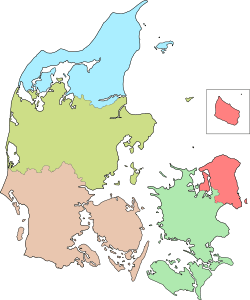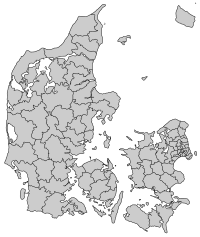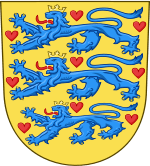Regions of Denmark
The five Regions of Denmark were created as part of the 2007 Danish Municipal Reform, when the counties (amter) were abolished. At the same time, the number of municipalities (kommuner) was cut from 270 to 98. The reform was made effective on 1 January 2007.
Each regional council has 41 members, from whom the regional chairman is chosen.
Unlike the counties (1970 - 2006) (Danish (singular) amtskommune, "county municipality"), the regions are not municipalities and therefore do not have the right to use a coat of arms, but they do have logos. As they are not municipalities they cannot move budgets from one area of expenditure to another, that is, use money for any other purpose than specifically stated, but must pay any money not used back rather like departments or agencies of the central government. They do not themselves levy any taxes, but are financed partly by block grants from a tax levied by the central government until 2018 and the ordinary income tax and partly by taxes collected by their constituent municipalities. The taxes of the municipalities were increased by 3 percentage points from 1 January 2007. This 3 percent is for patient care, which was previously a part of the county tax. The counties were financed both through their own county tax and in addition through block grants from central government.
The archipelago of Ertholmene slightly to the northeast of Bornholm is not part of any region or municipality. Therefore, its inhabitants do not pay the health care contribution tax levied by the central government from 1 January 2007 until 31 December 2018 and did not pay the tax levied by the counties prior to 2007 or any municipal taxes.
The representative organisation Danske Regioner was set up 23 March 2006. It is an advocacy and lobbying organisation speaking on behalf of all of the regions, including negotiating labour contracts, etc. The organization also maintains an office in Brussels.
The regions have the same structure as the five State Administrations (Danish: Statsforvaltninger; singular: Statsforvaltning).
List of regions
The naming of the regions in English are not uniform. The government often uses the Danish names[1] or directly translated English names (e.g. Greater Copenhagen, Zealand, North Jutland, Southern Denmark, Central Jutland).[2]
| Danish name (literal translation) | Official self-appellation in English1 | Seat of administration (largest city if different) | Chairman | Population2 (2018-01-01) | Total area2 (km²) | Pop. density (per km²) | Former counties (1970–2006) |
|---|---|---|---|---|---|---|---|
| Region Hovedstaden ("Capital Region") | Capital Region of Denmark[3] | Hillerød (Copenhagen) | Sophie Hæstorp Andersen | 1,822,659 | 2,546.3 | 715.8 | Counties:Copenhagen, Frederiksborg; municipalities: Copenhagen, Frederiksberg, Bornholm |
| Region Midtjylland ("Mid Jutland Region") | Central Denmark Region[4] | Viborg (Aarhus) | Anders Kühnau | 1,313,596 | 13,000.2 | 101.04 | Ringkjøbing, nearly all of Århus, the southern part of Viborg and the northern part of Vejle |
| Region Nordjylland ("North Jutland Region") | North Denmark Region[5] | Aalborg | Ulla Astman | 589,148 | 7,874 | 74.82 | North Jutland, the northern part of Viborg County and a small part of Århus County |
| Region Sjælland ("Region Zealand") | Region Zealand[6] | Sorø (Roskilde) | Heino Knudsen | 835,024 | 7,217.8 | 115.68 | Roskilde, Storstrøm, and West Zealand |
| Region Syddanmark ("Region of Southern Denmark") | Region of Southern Denmark[7] | Vejle (Odense) | Stephanie Lose | 1,220,763 | 12,191 | 100.13 | Funen, Ribe, South Jutland and the southern half of Vejle County |
| Danmark (Denmark) | N/A | Copenhagen | N/A | 5,781,190 | 42,894.8 | 134.77 | (Counties of Denmark) |
1 The regions themselves use English names that are not necessarily a verbatim rendering of the Danish name.
2 Area and population figures do not add up. Land area: 42,394 km². Inland water area: 500 to 700 km². Ertholmene included in totals. Statistikbanken.dk/FOLK1A.
Population growth
| Year | Region Hovedstaden |
Region Sjælland |
Region Syddanmark |
Region Midtjylland |
Region Nordjylland | |||||
|---|---|---|---|---|---|---|---|---|---|---|
| Population | Growth | Population | Growth | Population | Growth | Population | Growth | Population | Growth | |
| 2006 | 1,633,565 | 3,184 | 811,511 | 4,607 | 1,185,851 | 3,966 | 1,219,725 | 7,703 | 576,807 | 165 |
| 2007 | 1,636,749 | 9,076 | 816,118 | 3,309 | 1,189,817 | 4,842 | 1,227,428 | 9,613 | 576,972 | 1,867 |
| 2008 | 1,645,825 | 16,460 | 819,427 | 1,825 | 1,194,659 | 5,008 | 1,237,041 | 10,691 | 578,839 | 1,676 |
| 2009 | 1,662,285 | 17,986 | 821,252 | −688 | 1,199,667 | 610 | 1,247,732 | 6,266 | 580,515 | −887 |
| 2010 | 1,680,271 | 19,116 | 820,564 | −801 | 1,200,277 | 379 | 1,253,998 | 6,995 | 579,628 | 201 |
| 2011 | 1,699,387 | 15,202 | 819,763 | −1,856 | 1,200,656 | 686 | 1,260,993 | 5,689 | 579,829 | 167 |
| 2012 | 1,714,589 | 17,479 | 817,907 | −1,548 | 1,201,342 | 77 | 1,266,682 | 5,828 | 579,996 | 276 |
| 2013 | 1,732,068 | 17,337 | 816,359 | 367 | 1,201,419 | 1,090 | 1,272,510 | 5,028 | 580,272 | 785 |
| 2014 | 1,749,405 | 18,720 | 816,726 | 3,754 | 1,202,509 | 3,219 | 1,277,538 | 5,212 | 581,057 | 1,575 |
| 2015 | 1,768,125 | 21,049 | 820,480 | 7,019 | 1,205,728 | 6,042 | 1,282,750 | 10,559 | 582,632 | 2,867 |
| 2016 | 1,789,174 | 18,230 | 827,499 | 5,054 | 1,211,770 | 5,454 | 1,293,309 | 10,944 | 585,499 | 1,836 |
| 2017 | 1,807,404 | 15,255 | 832,553 | 2,471 | 1,217,224 | 3,539 | 1,304,253 | 9,343 | 587,335 | 1,813 |
| 2018 | 1,822,659 | 835,024 | 1,220,763 | 1,313,596 | 589,148 | |||||
Note: Numbers for the year 2006 are pro forma to be a reference, an example, to compare (neighboring) regions and changes in population numbers when the economy was expanding, growing as opposed to when it was contracting.[8]
Functions
- Health sector, including hospitals, psychiatry and health insurance, general practitioners and specialists.
- Health insurance for basic dental care.
- Regional development concerning nature and the environment, private sector economy, tourism, employment, education, and culture, outlying areas and rural area development. Administrative assistance for private sector growth fora.
- Ground pollution surveillance and cleanup.
- Raw material mapping and planning. Permission for extraction, i.e. gravel pits.
- Social and educational institutions for people with special needs.
- Public transportation.
The most important area of responsibility for the new regions is the public health service, accounting for 90% of the regions' expenditure. They are also responsible for employment policies and public mass transit (buses and a few local railways). However, in eastern Denmark (Region Zealand and the Capital Region) the regions and 45 out of 46 municipalities share one employment region and transit is handled by a single transport agency, Movia.
Bornholm Regional Municipality because of its remote location in the Baltic Sea between Sweden and the westernmost part of Poland is its own employment region and is a 100% owner of its own mass transit agency, BAT, which was Bornholms Amts Trafikselskab until the island's county was abolished on 1 January 2003. Bornholm also performs other tasks that are normally carried out by the regions in the rest of Denmark - thus the name Bornholm Regional Municipality: Bornholm in some respects forms a region by itself. From 1 January 2018 Fanø Municipality will be the sole provider of public mass transit on the island of Fanø taking over the responsibilities from the Region of Southern Denmark.
Administration and politics
Regions are led by directly elected councils (regionsråd), which each consist of 41 members. The head of the council is the regional council chairman (regionsrådsformand), who is elected by the council from its members.[9] Elections are held simultaneously with municipal elections every four years. The latest Danish local elections were held on 21 November 2017.
Unlike the former counties, regions are not entitled to levy their own taxes, but rely on central state funding (around 70%) and funding from the municipalities (around 30%). A central government "health contribution" tax (sundhedsbidrag) on income which was 8% when it was introduced from 2007 has replaced most of the county tax (amtsskat). With income taxes in the lowest bracket being raised 1 percentage point a year, the health contribution tax will be eliminated by 2019. In 2012 this tax was lowered to 7%, 2013 6%, 2014 5%, 2015 4%, 2016 3%, 2017 2%, 2018 1%. This follows an agreement on taxes by the Folketing from 2009.
90% of the budgets of the regions is allocated to the national health service. Health has remained the main issue in regional politics, especially because major changes to Denmark's hospital layout were announced immediately after the municipal reform.
History
The reform has been called the biggest reform in thirty years. It was an important policy issue for the former Liberal-Conservative cabinet, most importantly for Lars Løkke Rasmussen, then minister of the Interior and Health.
The abolition of the counties had long been an important goal for both the Conservatives and the Danish People's Party. 24 June 2004 the Danish People's Party decided to back the government's proposal for a structural reform of the public sector, thus securing a majority in the Danish parliament (Folketing), although the party had preferred just abolishing the counties without replacing them with a new administrative level between the central government and the municipalities. The parties who wanted to limit the regional tier of government prevailed insofar as the regions have no authority to levy taxes, and are not municipalities unlike the former counties (1970 - 2006) (Danish amtskommune, literally county municipality), and therefore cannot move budgets from one area of expenditure to another but must pay back any money not used, rather like departments or agencies of the central government.
State administrations
The 5 state administrations (statsforvaltninger;singular statsforvaltning) are the representations of the central government in the five regions. They belong to The Ministry of the Interior and Health. Their jurisdictions follow the regional borders. These administrations are not subordinate to the regional councils, but rather the direct presence of the state (similar to governorates or prefectures in certain countries).
A state administration office exists in each region, supervising the daily business of municipalities and regions, and functioning as a body of appeal for citizens who wish to complain over a decision by the municipality or region. The offices also handle affairs concerning adoption, citizenship and divorces.
Each office is led by a Director of the State Administration (forvaltningsdirektør) who is a university graduate in law.
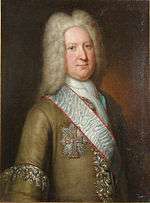
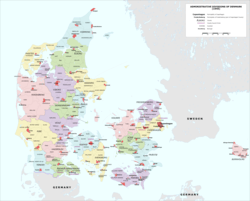
The predecessors of the 5 state administrations, before the 2007 reform, were the 15 state counties (plural, statsamter; singular, statsamt). One of these state counties, the prefecture in Copenhagen Municipality, was called the 'Upper Presidium of Copenhagen' (Københavns Overpræsidium). Each of these was led by a government official, the county prefect ((stats)amtmand). In Copenhagen he was called the 'Lord President of Copenhagen' (Københavns overpræsident), a title dating from 1747, but not widely known by the public. In some counties the prefect also performed the duty of overseeing the financial administration of the church as a diocesan county prefect (stiftamtmand), also being a part of the diocesan authorities within the National Church. Since 1 January 2007 this task has been performed by the Director of the State Administration. Also, the county prefect in his uniform would be the person to receive the Queen on her visits throughout the country.
The county prefect was also the political leader of the county council until the first municipal reform of 1970, when this task was taken over by the county mayor (amtsborgmester) who was one of the elected county council members. In Copenhagen Municipality, the switch was made in 1938 when the title of Lord Mayor of Copenhagen (Københavns overborgmester) was created.
With the exception of cases concerning divorce and child custody, the general public are not acquainted with the role of the prefectures (from 1970) or the 5 State Administrations (from 2007).
See also
References
- ↑ E.g. [Statistics Denmark] in the Statistical Yearbook 2009, page 32
- ↑ English names of state administrations Archived 2008-03-27 at Archive.is
- ↑ https://www.regionh.dk/english/Pages/default.aspx
- ↑ http://www.rm.dk/om-os/english/
- ↑ http://www.rn.dk/service/english
- ↑ http://www.regionsjaelland.dk/Kampagner/English/Sider/default.aspx
- ↑ https://www.regionsyddanmark.dk/wm228983
- ↑ Statistikbanken.dk/BEV107
- ↑ The Danish Regions – in Brief (3rd revised edition. ed.). Copenhagen: Danske Regioner. 2007. ISBN 978-87-7723-471-2.
External links
- Danish Regions Official homepage (13. February 2013). Retrieved on 9 August 2014.
- Danish Ministry for Economic Affair and the Interior - Statistics department Statistical information about Danish regions and municipalities (in Danish)
- Explanation of and background for Municipal Reform – with links to the Danish Ministry of the Interior and Health (in English)
- The agreement on the Municipal Reform – from the Danish Ministry of the Interior and Health (in Danish)
- The Ministry´s home page with report from the Commission on Administrative Structure etc.
- Home page of Regions. Click on map to access a Region's home page (in Danish)
- Budget of the Regions(in Danish)
- Statistikbanken.dk Budget
- Statistikbanken.dk Budget(in Danish)
- English home page of State Administrations
- Areas of concern (adoption etc.) (in English)
- Ministry of Employment
- Links to the 4 employment regions(in Danish)
- Regionalization and devolution: Proposed new regions of Norway (powerpoint slide show)
- Maps (pdf) showing local/regional administration 1660-2007(in Danish)
- Map with named municipalities and regions
- Krak searchable/printable map(outline of municipality visible, but does not print out!)
- Statistics Denmark
- Region Danmark
